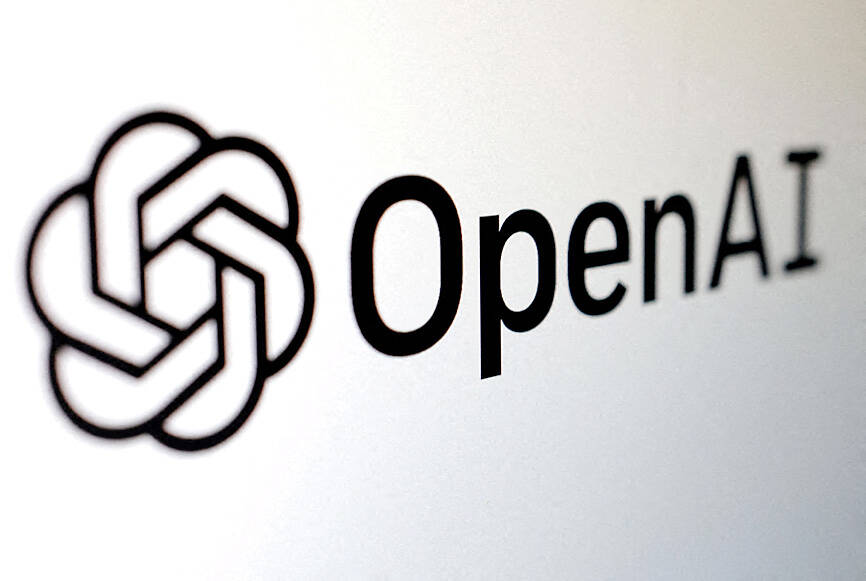OpenAI on Tuesday said it had reached an agreement for Sam Altman to return as CEO, days after his ouster, capping frenzied discussions about the future of the start-up at the center of the artificial intelligence (AI) boom.
In addition to Altman’s return, the company agreed in principle to partly reconstitute the board of directors that had dismissed him, with former Salesforce co-CEO Bret Taylor and former US secretary of the treasury Larry Summers joining Quora CEO Adam D’Angelo, OpenAI said.
“[I]’m looking forward to returning to openai,” Altman wrote on X, formerly Twitter.

Photo: Reuters
The board had given few details explaining Altman’s firing on Friday, other than his lack of candor and its need to defend OpenAI’s mission developing AI to benefit humanity.
The deal to restore Altman ushers in a potentially new era for the start-up, a non-profit, which long juggled concerns among staff about AI’s dangers and its potential for commercialization.
Tuesday’s reshuffle appeared to favor Altman and financial backer Microsoft Corp, which is rolling out OpenAI’s technology to business customers globally.
In a statement on X, Microsoft CEO Satya Nadella welcomed the changes to OpenAI’s board.
“We believe this is a first essential step on a path to more stable, well-informed, and effective governance,” he wrote.
Altman’s return also caps a tumultuous weekend that saw him agree to head a new research team at Microsoft, which has invested billions of US dollars in OpenAI and given it the computing power necessary for its technology.
That followed a rejection by OpenAI’s board of his first attempt to return to the start-up, on Sunday, by naming Twitch cofounder Emmett Shear as interim CEO.
“While it’s still unclear exactly what the tug-of-war prompting his initial departure involved, Sam Altman’s views about how to run the company will dominate future direction, especially given he’ll be supervised under a new board,” said Susannah Streeter, head of money and markets at Hargreaves Lansdown PLC.
Shear celebrated the late-night outcome on Tuesday on X, saying it followed “~72 very intense hours of work.”
“This was the pathway that maximized safety alongside doing right by all stakeholders involved,” Shear wrote.
Altman’s dismissal had brought uncertainty for OpenAI and Microsoft alike, which had moved quickly to control damage over the weekend by vowing to hire him and OpenAI president Greg Brockman.
Brockman, who had quit after Altman was ousted, wrote on X that he was “getting back to coding tonight.”
Nearly all of OpenAI’s more than 700 staff on Monday had threatened to leave unless the board stepped down and reinstated Altman, a letter reviewed by Reuters said.
Following this show of solidarity, Altman wrote on X: “we have more unity and commitment and focus than ever before.”

Nvidia Corp chief executive officer Jensen Huang (黃仁勳) on Monday introduced the company’s latest supercomputer platform, featuring six new chips made by Taiwan Semiconductor Manufacturing Co (TSMC, 台積電), saying that it is now “in full production.” “If Vera Rubin is going to be in time for this year, it must be in production by now, and so, today I can tell you that Vera Rubin is in full production,” Huang said during his keynote speech at CES in Las Vegas. The rollout of six concurrent chips for Vera Rubin — the company’s next-generation artificial intelligence (AI) computing platform — marks a strategic

Enhanced tax credits that have helped reduce the cost of health insurance for the vast majority of US Affordable Care Act enrollees expired on Jan.1, cementing higher health costs for millions of Americans at the start of the new year. Democrats forced a 43-day US government shutdown over the issue. Moderate Republicans called for a solution to save their political aspirations this year. US President Donald Trump floated a way out, only to back off after conservative backlash. In the end, no one’s efforts were enough to save the subsidies before their expiration date. A US House of Representatives vote

REVENUE PERFORMANCE: Cloud and network products, and electronic components saw strong increases, while smart consumer electronics and computing products fell Hon Hai Precision Industry Co (鴻海精密) yesterday posted 26.51 percent quarterly growth in revenue for last quarter to NT$2.6 trillion (US$82.44 billion), the strongest on record for the period and above expectations, but the company forecast a slight revenue dip this quarter due to seasonal factors. On an annual basis, revenue last quarter grew 22.07 percent, the company said. Analysts on average estimated about NT$2.4 trillion increase. Hon Hai, which assembles servers for Nvidia Corp and iPhones for Apple Inc, is expanding its capacity in the US, adding artificial intelligence (AI) server production in Wisconsin and Texas, where it operates established campuses. This

US President Donald Trump on Friday blocked US photonics firm HieFo Corp’s US$3 million acquisition of assets in New Jersey-based aerospace and defense specialist Emcore Corp, citing national security and China-related concerns. In an order released by the White House, Trump said HieFo was “controlled by a citizen of the People’s Republic of China” and that its 2024 acquisition of Emcore’s businesses led the US president to believe that it might “take action that threatens to impair the national security of the United States.” The order did not name the person or detail Trump’s concerns. “The Transaction is hereby prohibited,”